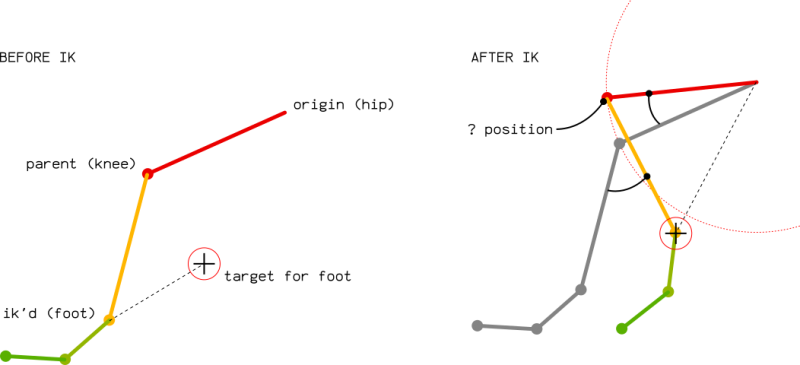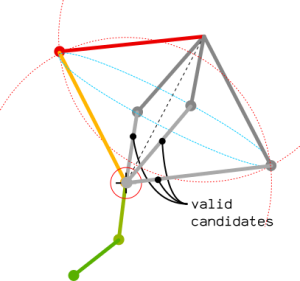Difference between revisions of "Notes:Inverse kinematics"
Frankiezafe (Talk | contribs) |
Frankiezafe (Talk | contribs) |
||
| Line 13: | Line 13: | ||
Rendering the position of the knee is crucial to compute the rotation to apply on the upper leg. Once correct, the rotation of the leg will be simple to render, as it is the rotation from the current direction to the [knee - target] direction. | Rendering the position of the knee is crucial to compute the rotation to apply on the upper leg. Once correct, the rotation of the leg will be simple to render, as it is the rotation from the current direction to the [knee - target] direction. | ||
| − | A little warning: the graphic here above is in 2d. In a 3d world, the position of the knee is a circle on a sphere: any point being at the right distance of the target point '''and''' the upperleg origin will be a valid candidate! | + | A little warning: the graphic here above is in 2d. In a 3d world, the position of the knee is a circle on a sphere: any point being at the right distance of the target point '''and''' the upperleg origin will be a valid candidate! The circle of possibilities is the intersection of 2 spheres having a radius equal to bones length. |
[[File:Solving-ik-002.png|300px]] | [[File:Solving-ik-002.png|300px]] | ||
Revision as of 15:26, 19 April 2018
Notes about computation of inverse kinematics[1]
At this moment, the research is focusing on solving a 2 bones system, the leg in this case, but it would be applicable on the arms or any other part of a skeleton having at least 2 parents.
The main issue seems to be the computation of the knee position. All distances are easily computed:
- upper leg (red) keeps its length
- leg (yellow) keeps its length also
- distance between the target and the origin of the upper leg can be easily computed in world space.
Rendering the position of the knee is crucial to compute the rotation to apply on the upper leg. Once correct, the rotation of the leg will be simple to render, as it is the rotation from the current direction to the [knee - target] direction.
A little warning: the graphic here above is in 2d. In a 3d world, the position of the knee is a circle on a sphere: any point being at the right distance of the target point and the upperleg origin will be a valid candidate! The circle of possibilities is the intersection of 2 spheres having a radius equal to bones length.
Therefore, we will need to render a direction vector based on:
- front axis of the leg or
- knee - target difference.
References
- Animation Bootcamp: An Indie Approach to Procedural Animation - a GDC talk about character animation in a computation effective way.

